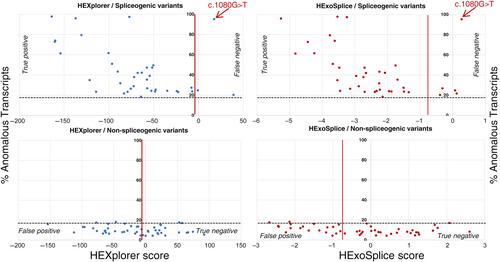Lara Sanoguera-Miralles, Inés Llinares-Burguet, Elena Bueno-Martínez, Lobna Ramadane-Morchadi, Cristiana Stuani, Alberto Valenzuela-Palomo, Alicia García-Álvarez, Pedro Pérez-Segura, Emanuele Buratti, Miguel de la Hoya, Eladio A Velasco-Sampedro
下载PDF
{"title":"Comprehensive splicing analysis of the alternatively spliced CHEK2 exons 8 and 10 reveals three enhancer/silencer-rich regions and 38 spliceogenic variants","authors":"Lara Sanoguera-Miralles, Inés Llinares-Burguet, Elena Bueno-Martínez, Lobna Ramadane-Morchadi, Cristiana Stuani, Alberto Valenzuela-Palomo, Alicia García-Álvarez, Pedro Pérez-Segura, Emanuele Buratti, Miguel de la Hoya, Eladio A Velasco-Sampedro","doi":"10.1002/path.6243","DOIUrl":null,"url":null,"abstract":"<p>Splicing is controlled by a large set of regulatory elements (SREs) including splicing enhancers and silencers, which are involved in exon recognition. Variants at these motifs may dysregulate splicing and trigger loss-of-function transcripts associated with disease. Our goal here was to study the alternatively spliced exons 8 and 10 of the breast cancer susceptibility gene <i>CHEK2</i>. For this purpose, we used a previously published minigene with exons 6–10 that produced the expected minigene full-length transcript and replicated the naturally occurring events of exon 8 [Δ(E8)] and exon 10 [Δ(E10)] skipping. We then introduced 12 internal microdeletions of exons 8 and 10 by mutagenesis in order to map SRE-rich intervals by splicing assays in MCF-7 cells. We identified three minimal (10-, 11-, 15-nt) regions essential for exon recognition: c.863_877del [ex8, Δ(E8): 75%] and c.1073_1083del and c.1083_1092del [ex10, Δ(E10): 97% and 62%, respectively]. Then 87 variants found within these intervals were introduced into the wild-type minigene and tested functionally. Thirty-eight of them (44%) impaired splicing, four of which (c.883G>A, c.883G>T, c.884A>T, and c.1080G>T) induced negligible amounts (<5%) of the minigene full-length transcript. Another six variants (c.886G>A, c.886G>T, c.1075G>A, c.1075G>T, c.1076A>T, and c.1078G>T) showed significantly strong impacts (20–50% of the minigene full-length transcript). Thirty-three of the 38 spliceogenic variants were annotated as missense, three as nonsense, and two as synonymous, underlying the fact that any exonic change is capable of disrupting splicing. Moreover, c.883G>A, c.883G>T, and c.884A>T were classified as pathogenic/likely pathogenic variants according to ACMG/AMP (American College of Medical Genetics and Genomics/Association for Molecular Pathology)-based criteria. © 2024 The Authors. <i>The Journal of Pathology</i> published by John Wiley & Sons Ltd on behalf of The Pathological Society of Great Britain and Ireland.</p>","PeriodicalId":232,"journal":{"name":"The Journal of Pathology","volume":"262 4","pages":"395-409"},"PeriodicalIF":5.6000,"publicationDate":"2024-02-09","publicationTypes":"Journal Article","fieldsOfStudy":null,"isOpenAccess":false,"openAccessPdf":"https://onlinelibrary.wiley.com/doi/epdf/10.1002/path.6243","citationCount":"0","resultStr":null,"platform":"Semanticscholar","paperid":null,"PeriodicalName":"The Journal of Pathology","FirstCategoryId":"3","ListUrlMain":"https://onlinelibrary.wiley.com/doi/10.1002/path.6243","RegionNum":2,"RegionCategory":"医学","ArticlePicture":[],"TitleCN":null,"AbstractTextCN":null,"PMCID":null,"EPubDate":"","PubModel":"","JCR":"Q1","JCRName":"ONCOLOGY","Score":null,"Total":0}
引用次数: 0
引用
批量引用
Abstract
Splicing is controlled by a large set of regulatory elements (SREs) including splicing enhancers and silencers, which are involved in exon recognition. Variants at these motifs may dysregulate splicing and trigger loss-of-function transcripts associated with disease. Our goal here was to study the alternatively spliced exons 8 and 10 of the breast cancer susceptibility gene CHEK2 . For this purpose, we used a previously published minigene with exons 6–10 that produced the expected minigene full-length transcript and replicated the naturally occurring events of exon 8 [Δ(E8)] and exon 10 [Δ(E10)] skipping. We then introduced 12 internal microdeletions of exons 8 and 10 by mutagenesis in order to map SRE-rich intervals by splicing assays in MCF-7 cells. We identified three minimal (10-, 11-, 15-nt) regions essential for exon recognition: c.863_877del [ex8, Δ(E8): 75%] and c.1073_1083del and c.1083_1092del [ex10, Δ(E10): 97% and 62%, respectively]. Then 87 variants found within these intervals were introduced into the wild-type minigene and tested functionally. Thirty-eight of them (44%) impaired splicing, four of which (c.883G>A, c.883G>T, c.884A>T, and c.1080G>T) induced negligible amounts (<5%) of the minigene full-length transcript. Another six variants (c.886G>A, c.886G>T, c.1075G>A, c.1075G>T, c.1076A>T, and c.1078G>T) showed significantly strong impacts (20–50% of the minigene full-length transcript). Thirty-three of the 38 spliceogenic variants were annotated as missense, three as nonsense, and two as synonymous, underlying the fact that any exonic change is capable of disrupting splicing. Moreover, c.883G>A, c.883G>T, and c.884A>T were classified as pathogenic/likely pathogenic variants according to ACMG/AMP (American College of Medical Genetics and Genomics/Association for Molecular Pathology)-based criteria. © 2024 The Authors. The Journal of Pathology published by John Wiley & Sons Ltd on behalf of The Pathological Society of Great Britain and Ireland.
对CHEK2第8和第10外显子的替代剪接进行综合分析,发现了三个增强子/沉默子富集区和38个剪接变体。
剪接由大量调控元件(SRE)控制,包括剪接增强子和沉默子,它们参与外显子的识别。这些基序的变异可能会导致剪接失调,并引发与疾病相关的功能缺失转录本。我们的目标是研究乳腺癌易感基因 CHEK2 的第 8 和第 10 号交替剪接外显子。为此,我们使用了以前发表的带有 6-10 号外显子的迷你基因,它产生了预期的迷你基因全长转录本,并复制了自然发生的 8 号外显子[Δ(E8)]和 10 号外显子[Δ(E10)]跳接事件。然后,我们通过诱变引入了 12 个外显子 8 和 10 的内部微缺失,以便在 MCF-7 细胞中通过剪接试验绘制富含 SRE 的区间。我们确定了对外显子识别至关重要的三个最小(10-, 11-, 15-nt)区域:c.863_877del [ex8, Δ(E8): 75%] 和 c.1073_1083del 和 c.1083_1092del [ex10, Δ(E10): 分别为 97% 和 62%]。然后将在这些区间内发现的 87 个变体引入野生型迷你基因并进行功能测试。其中 38 个(44%)损害了剪接,其中 4 个(c.883G>A、c.883G>T、c.884A>T 和 c.1080G>T)的诱导量可忽略不计(A、c.886G>T、c.1075G>A、c.1075G>T、c.1076A>T 和 c.1078G>T)显示出明显的强烈影响(占迷你基因全长转录本的 20-50%)。38 个剪接源变异中有 33 个被注释为错义,3 个为无义,2 个为同义,这说明任何外显子变化都能破坏剪接。此外,根据 ACMG/AMP(美国医学遗传学和基因组学学院/分子病理学协会)的标准,c.883G>A、c.883G>T 和 c.884A>T 被归类为致病/可能致病变异。© 2024 作者。病理学杂志》由 John Wiley & Sons Ltd 代表大不列颠及爱尔兰病理学会出版。
本文章由计算机程序翻译,如有差异,请以英文原文为准。


 求助内容:
求助内容: 应助结果提醒方式:
应助结果提醒方式:


